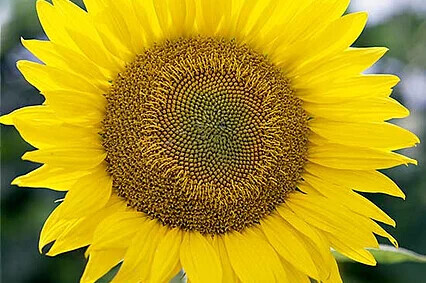When you think of sunflowers, perhaps you picture fields bursting with tall, bright yellow flowers that resemble the sun itself, but sunflowers can actually be purple, orange, or red—or even a mix of these hues. And not all of them are tall—there are dwarf varieties that grow only about a foot tall. On the other end of the height spectrum, you'll find giant varieties that can reach more than 10 feet tall! There are all sorts of varieties that grow anywhere in between these height extremes, too. Here are some of the most fascinating facts about these colorful plants.

1. Sunflowers Are Rooted in American Soil
The cheery blooms we call sunflowers are produced by an annual plant (Helianthus annuus) that originated in North America. As far back as 3000 BC, Native Americans grew them for medicine, oil, and food. They began breeding the plants to produce a single, large flower head instead of several smaller ones. In the 1500s, Spanish explorers brought sunflowers to Europe, where they soon became popular for their beauty and usefulness. By the 19th century, Russia alone was planting two million acres of sunflowers every year, and it is still one of the top countries in terms of commercial sunflower production. If you're feeling inspired to plant your own sunflowers, they are easy to grow from seeds. Just know that because they are annuals, they will only last one season.
2. Their Seeds Are Good for You
Sunflower seeds are a favorite snack at baseball games, where fans are often seen clutching bags of them. Many schools also recommend them as an allergy-friendly alternative to nuts. The shelled seeds make tasty additions to bread (like this Sunflower Seed Bread recipe) and other baked goods (like these Chocolate Chip Sunflower Cookies), or can be sprinkled over salads or into dishes like this Creamy BLT Coleslaw)—and they're highly nutritious. Sunflower seeds are a rich source of protein, potassium, magnesium, calcium, iron, and vitamin E. So, next time you're looking for a healthy snack, grab a handful of sunflower seeds and get cracking.
3. Sunlight Is A Must
Their name is no coincidence—sunflowers truly need sunlight to thrive. (Their sunny appearance also adds to the fitting name.) Sunflowers need at least six to eight hours of sunlight a day, but more time is ideal. The flower buds even display a unique behavior called heliotropism—they gradually move to follow the sun's position in the sky as it moves throughout the day from east to west. Once the buds open into flowers, their stems stiffen and remain in place with the flowers facing east all day long.
4. Thousands of Small Flowers Make Up One Sunflower
Sunflowers aren't simply one flower like they appear to be—they actually contain 1,000 to 2,000 smaller flowers. Each petal of the head of a sunflower is what botanists call a ray floret. The inner "eye" is made up of disk florets, which are arranged in mesmerizing patterns of interconnecting spirals. Only the disk florets develop into seeds, and they can either pollinate themselves, or cross-pollinate with other sunflowers with the help of wind or bees, butterflies, and other pollinators.
Related: You Can Register Your Garden for the Million Pollinator Garden Challenge
5. Sunflowers Are Icons in Art, Music, and Pop Culture
The Sunflowers series by Dutch post-impressionist painter Vincent Van Gogh is one of his most well-known works. The vivid oil paintings are a bright spot among some of Van Gogh's darker works and have inspired many other artists around the world. More recently, sunflowers were named one of the top three flowers in Minecraft, which has become the most popular video game of all time. And you might have found yourself humming along to "Sunflower" from the most recent Spider-Man movie.